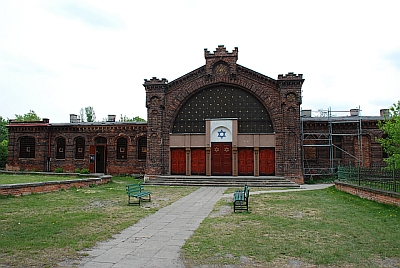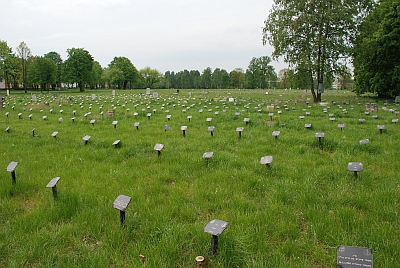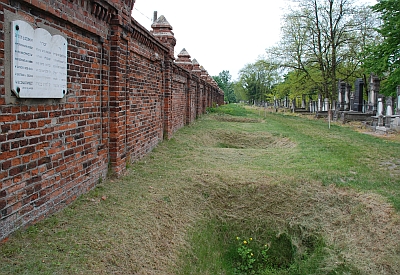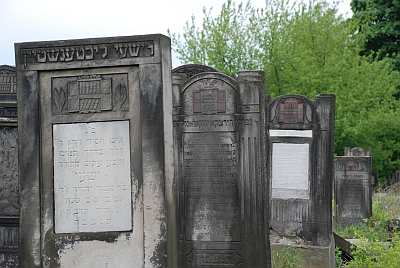This is the largest Jewish cemetery in Europe, covering more than 40 hectares. About 230,000 Jews are buried here. During the war, an estimated 45,000 people were interred in the so-called Ghetto Field.
 The cemetery was established in 1892. (The public entrance is on Zmienna Street, just south of Inflancka.) Some of the most important Lodz industrialists rest here. Immaculately-designed mausoleums are emblazoned with the names that colored this city's industrial power: Prussaks, Silbersteins, Poznanskis, Kons, Jarocinskis. These monuments tower next to the beautifully-modest headstones, or matsevot, of the lesser-privileged Jews from Franciszkanska or Stodolniana streets. Among the gravestones one can find names of renowned doctors, lawyers and artists. Families connected with the some of the greatest figures in the arts world add a distinct tone to the grounds. There are the parents of composer Arthur Rubinstein, artist Artur Szyk or poet Julian Tuwim. Here and there, the visitor comes across ohels (the tombs) of zaddikim and gravestones of Bundists, decorated with socialist symbols. The cemetery reflects an amazing blend of Jewish traditions, trends and attitudes, a reminder of the multi-layered and diverse Jewish community of pre-war Lodt.
The cemetery was established in 1892. (The public entrance is on Zmienna Street, just south of Inflancka.) Some of the most important Lodz industrialists rest here. Immaculately-designed mausoleums are emblazoned with the names that colored this city's industrial power: Prussaks, Silbersteins, Poznanskis, Kons, Jarocinskis. These monuments tower next to the beautifully-modest headstones, or matsevot, of the lesser-privileged Jews from Franciszkanska or Stodolniana streets. Among the gravestones one can find names of renowned doctors, lawyers and artists. Families connected with the some of the greatest figures in the arts world add a distinct tone to the grounds. There are the parents of composer Arthur Rubinstein, artist Artur Szyk or poet Julian Tuwim. Here and there, the visitor comes across ohels (the tombs) of zaddikim and gravestones of Bundists, decorated with socialist symbols. The cemetery reflects an amazing blend of Jewish traditions, trends and attitudes, a reminder of the multi-layered and diverse Jewish community of pre-war Lodt.
During the war, the site was incorporated into the ghetto and was commonly referred to as the "Cemetery at Marysin" A separate burial area was started in the southern part of the cemetery grounds for the victims who died in the ghetto. The death rate was shocking. Funerals of several dozen people were a daily occurrence, but on some days as many as 170, ghetto Jews would die.
 According to the Jewish community's archives, an estimated 45,000 victims were buried in this section during the years 1940-44. After the war, the area was named the Ghetto Field. It should be noted that there were no mass graves for Jews in Lodz. Efforts were made to ensure each body was buried in its own grave. Even though most of the graves here have no headstones, as a result of the detailed records that were kept, the place of burial for the vast majority of the ghetto victims can be found. Many of the Jews buried here were deportees from the regional area, brought in from the smaller ghettoes in Wloclawek, Glowno, Strykow, Brzeziny, Sieradz, Zdunska Wola or Wielun.
There are also the graves of those deported from Austria, Czechoslovakia, Luxembourg and Germany.
According to the Jewish community's archives, an estimated 45,000 victims were buried in this section during the years 1940-44. After the war, the area was named the Ghetto Field. It should be noted that there were no mass graves for Jews in Lodz. Efforts were made to ensure each body was buried in its own grave. Even though most of the graves here have no headstones, as a result of the detailed records that were kept, the place of burial for the vast majority of the ghetto victims can be found. Many of the Jews buried here were deportees from the regional area, brought in from the smaller ghettoes in Wloclawek, Glowno, Strykow, Brzeziny, Sieradz, Zdunska Wola or Wielun.
There are also the graves of those deported from Austria, Czechoslovakia, Luxembourg and Germany.
Not all of the ghetto dead, however, were buried in the Ghetto Field. Many people would bury their relatives in the cemetery alleys and near their family graves. The grave of Dawid Sierakowiak, the young author of a diary from the Lodz ghetto, is located near the Poznanski family mausoleum. It was recently discovered that Maurycy Trebacz, a renowned Jewish painter that died of starvation in the ghetto in January 1941, is buried in what is called the New Field.
More than 700 Gypsies who died in the so-called Gypsy Camp in late 1941 and early 1942 were buried in an area identified as Section PV and PVI. Those that did not succumb to the horrific conditions of the Gypsy Camp, an estimated 4,300 people, were sent off to the death camp at Chelmno-nad-Nerem and killed.
The western part of the cemetery was a place where members of the Polish resistance were executed and buried, most notably soldiers of the Home Army (Armia Krajowa).
Among the victims buried in the Jewish Cemetery are also Christians that had inter-married with Jews. These individuals voluntarily entered the ghetto to remain with their Jewish spouses. There are also the graves of people that had converted to Christianity, but were still labeled Jewish according to the racist Nuremberg laws. This, for the most part, involved the deportees from outside Poland.
 Several pits mark the ground along a wall inside the cemetery. The Jews left behind after the final liquidation of the ghetto were ordered to dig the pits.
These holes were intended to be mass graves for the people that remained to clean up the area. The Nazis, however, could not carry out their plans. The Russian military was approaching. The Nazi officers panicked and fled. The survivors later decided to leave the pits as they were, to remember. "This is our grave" the survivors emphasize.
Several pits mark the ground along a wall inside the cemetery. The Jews left behind after the final liquidation of the ghetto were ordered to dig the pits.
These holes were intended to be mass graves for the people that remained to clean up the area. The Nazis, however, could not carry out their plans. The Russian military was approaching. The Nazi officers panicked and fled. The survivors later decided to leave the pits as they were, to remember. "This is our grave" the survivors emphasize.
Over the decades, a collection of plaques remembering those dark years have appeared along this wall near the entrance. These words are a solemn reminder of the Jewish people that died of starvation and emaciation in the ghetto; they are a reflection of family members that perished in the Nazi death camps. This wall pays homage to the Lodz Jews, to the Jews cruelly herded into the ghetto from surrounding towns and villages, to those brutally transported here from other European countries. The words reflect an international cry in Polish, English, Hebrew, German. These memorial plaques were erected by individuals and families from around the world - France, Australia, the United States, Israel - by people who miraculously survived the Nazi terror, by the children and relatives of those that were killed.
In October 2001, a delegation of Czech Jews dedicated a plaque in memory of their brethren that were deported in autumn 1941 and ultimately lost their lives in the ghetto or the Nazi death camps. The plaque is positioned on the outer side of this cemetery wall.
Nearby, there is a monument that pays homage to the victims of the ghetto and the Nazi camps. The monument was erected in 1956. The light-colored stone obelisk resembles that of a crematorium chimney. A menorah, the great symbol of Jewish life, and a broken tree, traditionally an image of death, are also a part of the design. A black marble tablet asserts in Polish, Hebrew and Yiddish: "The memory of you will remain in our hearts forever."
In 1980, the Jewish Cemetery in Lodz was proclaimed a historical site. In 1996, the Monumentum Iudaicum Lodzense Foundation was established in an effort to help preserve the heritage of Jewish Lodz, the cemetery in particular. Since then, renovations and maintenance projects have been implemented. These efforts are also supported by other institutions, foundations and private donations.
 It was a dark night. The biting wind was chilling me to the bone. It was a few degrees below zero. I was at the Jewish Cemetery in Lodi, next to the Poznanski family vault. I was waiting for a smuggler who was to walk me through the Reich border to the General Gouvernement. I had to wait from 8 p.m. to 5 a.m. That was the way we agreed, in order not to evoke any suspicions […]. I took a nap on the vault's stairs. I was woken up by a strange rustle. Fortunately, it wasn't the Nazis. A man and a woman were using a shovel. I knew why: they were burying their belongings. The cellars became insecure since the Germans had dug them up one meter deep, searching for Jewish treasures.
It was a dark night. The biting wind was chilling me to the bone. It was a few degrees below zero. I was at the Jewish Cemetery in Lodi, next to the Poznanski family vault. I was waiting for a smuggler who was to walk me through the Reich border to the General Gouvernement. I had to wait from 8 p.m. to 5 a.m. That was the way we agreed, in order not to evoke any suspicions […]. I took a nap on the vault's stairs. I was woken up by a strange rustle. Fortunately, it wasn't the Nazis. A man and a woman were using a shovel. I knew why: they were burying their belongings. The cellars became insecure since the Germans had dug them up one meter deep, searching for Jewish treasures.
Edward Reicher, In the Sharp Daylight, p. 30.
I came to the cemetery much too early and, thus, I had to wait for the black wagon to arrive. The first body taken out of it was that of my dad. A label with his name, Anszel Kalman Plager, was attached to his foot. My beloved dad, who had always been an intrinsic part of my life!
Sara Zyskind, The Stolen Years, p. 130.

 Home
Home
